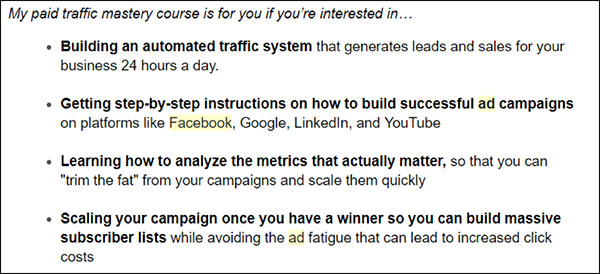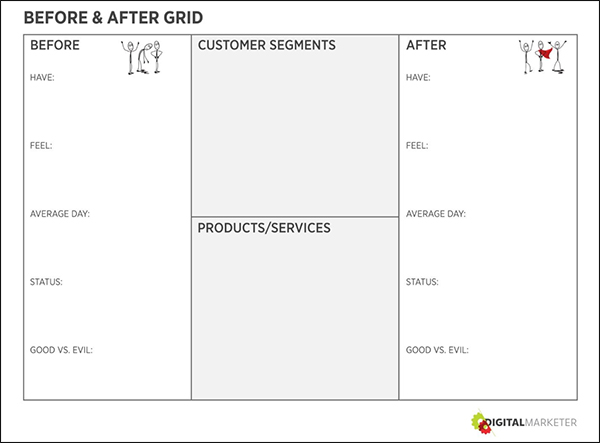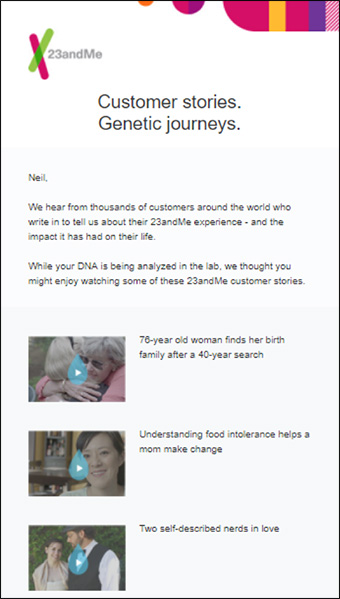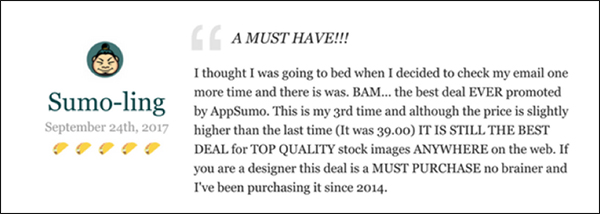I hate to be the one to break it to you, but…
No one, especially not your ideal customer, is sitting around wondering why they haven’t gotten your promotional email today.
This shouldn’t come as a surprise to you. Your prospects are busy people, and they’ve got important things going on in their lives.
Oh and they probably receive at least twenty emails from other companies each day, all wanting the same thing you want, their attention (and maybe their money too, but that comes second).
When you send an email out to your list, you have only a few seconds to grab their attention before they delete it and move on with their day.
So how can you make the MOST of those precious seconds and start to bridge the gap from interruption…
…to attention…
…to transaction?
The answer is simple but not easy.
(Wrap your mind around that for a second…)
Here at DigitalMarketer, we’ve come up with 4 simple questions we ask ourselves before we write every email. I’m betting that if you answer the same 4 questions, your emails will be more relevant, compelling, and engaging to your audience.
Oh, and you’ll probably generate more sales too…
Let’s get started with the first question!
Question 1: “Why Now?”
Email by nature is interruptive. So when you interrupt someone, you’d better be able to quickly explain why… and it had better be good.
That being said, maybe a better way to ask this question is:
“Why should your subscriber stop what they’re doing and give you their attention NOW?”
Keep in mind there are probably 2 very different answers to this question: there’s your answer, that ultimately benefits YOU, and there’s what you say to your subscriber… and it better benefit them (or you shouldn’t be interrupting them in the first place).
Your answer might be:
“I’m sending you this email now to increase sales.”
Or,
“Because I spent money to get you on this email list and my boss is insisting that I need to show a profit on that advertising spend.”
While this may be an honest answer to the question for you, it can’t be the answer you tell the person receiving the email.
Imagine receiving an email like that yourself…
“Sorry to interrupt but I’m about to miss my quota so could you please stop what you’re doing and buy this real quickly? Thanks!”
While that email would probably grab your intention, and likely even move you to action… it probably would not be a purchasing action.
Instead of focusing on your why, the answer needs to focus on your customer. Ask the question “Why now?” from their point of view.
Instead of focusing on your why, the answer needs to focus on your customer.
In some cases the answer will be straightforward, because your offer will be…
- Because it’s new…
- Because it’s on sale
- Because it’s time-limited or time-sensitive…
- Because it’s exclusive
Here’s a great example from Kate Spade. They answer the question “Why now?” right in the subject line of their email:

Why is Kate Spade emailing you now? The answer is clear:
Because there’s a $99 sale going on, and you have only 1 day to take advantage of it!
But what if none of those things are true? What if your email isn’t new, promoting a sale, time-limited, exclusive, or timely? Then how do you answer this question?
Start by thinking about some of the resources you have available. You may not have a sale or a time-limited offer to promote, but do you have customer reviews or testimonials? Case studies? Valuable content?
Are any of those resources relevant to your prospect’s situation right now?
Let’s say that you have a testimonial from a customer who was skeptical at first, but then purchased your product and experienced great results.
In that case, you could say something like this in an email to prospects who have not yet converted:
Hey [Name],
I got this in my inbox last night and it made me think of you.
I know you said you wanted to achieve [desired end result], and thought it might be helpful for you to hear how someone else did it using our product or service.
See what we’re doing here?
First of all, we start out by telling the prospect that we were thinking about them. This triggers a powerful emotional reaction..
Most people are only thought about by their parents, their spouse, their kids maybe a few close friends.
So telling someone “I was thinking about you last night…” is a great way of grabbing their attention-because it’s not something most of us hear very often.
Psychologically, it’s a powerful thing to say because it makes them FEEL thought of.
It also answers the first question. Why am I emailing you now? Well, in this case, because I saw something that made me think of you.
This is a great way of grabbing the prospect’s attention… and then focusing that attention on one of your customer stories or testimonials that addresses their current objections from a credible third-party source, someone just like them.
Question 2: “Who Cares?”
Now that you’ve cleared up why you’re emailing the person NOW, the next thing you need to figure out is…
“Who cares?”
In other words, who would be most affected, positively or negatively, by having or not having your product or service?
This question is important because it tells your ideal customer that you understand who they are and what they want… you’re a friend who listens when they talk and is here to help.
In traditional direct response, this was often done with pre-headlines that read something like this:
“Attention: Sales people who need more leads”
“Attention: Ecommerce sellers who need more sales”
“Attention: Anyone who wants to get a better night’s sleep”
I’m not saying you need to go that far in your emails. But the idea of calling out your audience is definitely a shortcut that will grab their attention by letting them know right away that you’re speaking to them or at least speaking about something that they’re interested in.
This is an effective strategy that we used in our emails at DigitalMarketer quite often. Here’s an example of an email calling out a specific audience (marketing agencies):

If you use this technique in your emails, just make sure that you’re being specific enough without being too specific.
For example, if you begin your email:
“Dear VP of Marketing…”
That’s a really specific opening. It’s probably going to turn off anyone who doesn’t fit that exact title.
What if your audience could include Directors or Marketing, Marketing Managers, and so on?
The trick here is to be specific enough to include everyone in your target market… without being so broad that you aren’t really speaking to anyone in particular.
You want your prospect to open your email and instantly think:
“Oh, they’re talking to ME here.”
(NOTE: Tired of your email marketing being mostly guess work? Use this FREE plug and play guide and tracking sheet to track, analyze, and optimize your email marketing strategy. Download it here!)
Question 3: “Why Should They Care?”
Now that you’ve clarified “who,” it’s your job to paint a clear picture of “why.”
“Why should they care??”
Why should your subscriber or prospect care about the message in your email?
If you’re promoting a product or service, how is that product or service going to benefit them?
What does their life look like before and after they start using your product or service?
How will you make their average day better or easier?
This is a crucial question to ask, and answer, because it’s so easy to spend the entire email talking about yourself…
“We’re the #1…”
“Our product is…”
“For years we’ve been…”
The truth is that none of your prospects care about you, your company, or your product.
They care about themselves. And the only way they’re going to become interested in your product is if they can see how it benefits them.
One of the oldest and easiest ways of demonstrating this is with a good old before and after (B&A) picture. These images are extremely persuasive for weight-loss products because they show you, at a glance, how dramatically the product can benefit the reader.
Here’s an example of a B&A pic from a BioTrust email:

If you can portray the benefit of your product or service in a visual way like this, that’s a powerful way of communicating value and convincing people to care about what you have to say.
Communicating benefits like this might sound fairly straightforward. And often, it is. But let me make a caveat:
Sometimes you will need to take extra steps to make sure to explain how your product or service is going to benefit your prospect-because this is not always self-evident to your readers the way it seems self-evident to you.
Just what do I mean by that?
As marketers and salespeople, we have to deal with the curse of knowledge.
We’re so close to our own business that we know it inside and out… and sometimes it’s hard to forget what we know and see things from our customer’s point of view.
And because of this curse of knowledge, sometimes we assume that our audience is going to connect the dots when they really aren’t.
Here’s a snippet of copy from an email I received:

This copy is good and it points out some great features that probably really resonate and call out to their ideal customer. BUT, I’d be willing to bet that it would have worked even better if it would have FIRST focused on the desired end result or ideal day, something like this:
“Imagine standing up from your desk 20 minutes after 5,000 words just flowed fluidly on to the page… your work was automatically saved and backed up safely so you don’t even have to press save before you take a quick walk as a reward for a job well done.”
This bridges the gap between what you know about the benefits of your product and the features that lead to your prospect experiencing them.
Think about it, the original copy asks a lot of the person reading the email.
They have to:
- Know the benefit of setting session goals
- Know the pain of losing work because it didn’t automatically save (and connect that pain to this product as a solution)
- Acknowledge that distractions are a big reason that they’re not getting their writing done
What does their life look like before and after they start using your product or service?
In a nutshell, this paragraph tells you what the product does… but it doesn’t tell you why you should care. Just adding my copy before their copy changes everything because the reader understands that the end result is finishing their writing and then rewarding themselves.
They have to say, “I want to experience that” before they can ask “how”…
Let’s go through another example. Imagine we’re sending an email to promote an offer-let’s say it’s a Facebook ads course.
Now because we’re marketing experts, and we’re thoroughly familiar with this course (not to mention Facebook advertising in general), it’s easy for us to assume that the person reading this email will instantly grasp how this offer can benefit them by bringing traffic to their website, retargeting website visitors who didn’t convert, and so on.
But maybe they won’t.
Maybe they don’t know much about Facebook advertising. They might assume that it is only for companies with a huge social media following, or B2C companies, etc. They might not realize how much this FB ads course could help their business.
When that happens, your reader is often left wondering: “Is this relevant to my situation? Will this work for MY company?”
And the odds are pretty high that they’re going to close out of your email without ever really listening to what you have to say-because they didn’t understand WHY they should care about your message.
That’s why we, as marketers, sometimes need to make that connection for them. Here’s an example of how we accomplished this using bullet points in an email for our Customer Acquisition Specialist Masterclass & Certification:

Here, as you can see, we’re telling people exactly why they should care about this mastery course. Because it will help you build an automated traffic system that generates leads and sales for your business 24 hours a day. Because you’ll learn how to analyze the metrics that actually matter to help you scale your campaigns. And so on.
Here’s another thing to keep in mind. The more evocative you can be when you’re communicating these benefits, the better.
For example, if you’re in the golf industry then your ideal customer is obviously a golfer but you wouldn’t just say “Hey, want to golf better? Or even “Want to shoot a lower score?”
It’s not specific enough… no one knows exactly what it feels like to “shoot a lower score.”
If you wanted to speak to their language, you’d say something like:
“This will add 50 yards to your drive”
That gets the message across, technically, but it doesn’t help the person to FEEL that benefit.
Now if you can paint a picture and evoke an emotional response, your message will make a much bigger impact on the reader. Notice how much more powerful this feels:
“Imagine you walk up to the first tee and hit it on your first swing… your ball flies 280 yards and lands just over the furthest bunker, right in the middle of the fairway. You turn around and see your buddy’s jaw hanging open, and you know he just died a little inside watching you hit a shot like that.”
You see how much more evocative that is? How it describes the prospect’s life after they’ve used your product or service? How it hits on the real hot-button emotional triggers like vanity and social status?
Copywriters call this “future pacing,” and it’s an extremely powerful way to pull readers into your emails.
Heroes & Vehicles
When you’re thinking about question #3, remember this:
Imagine your prospect as they are right now as being at “point A.”
Then understand that what they want to be, their desired end result, is “point B.” This describes your prospect the way they WANT to be: thinner, richer, more popular, getting that raise at work, and so on.
Your prospect wants to go from A to B. Ryan talks about this a lot in his “Before & After Grid”:

But here’s an important thing to keep in mind (and a lot of marketers get this wrong):
You can NEVER be the hero in your ideal customers story… that’s their job. You’re the guide and your product or service is the vehicle.
Many companies try to position their product as the hero. But again, your product is NEVER the hero! The prospect is the hero. Your product or service is more like the vehicle, the guide, or the mentor who helps them to achieve whatever it is that they want.
Remember that everyone wants to be the hero of their own life, and the job of your product or service is not to be the hero for them… but to be the vehicle that helps them shine.
So if your prospect is King Arthur, then your product is Excalibur and you’re Merlin. If your prospect is Luke Skywalker, then your product is the force and you’re Yoda.
I could keep going, but I’m sure you get the idea.
Question 4: “How Can You Prove It?”
In question #3 you explored WHY your prospect should care about your message, by communicating how it can act as the vehicle that delivers them to their desired end result.
But just because you tell them what your product or service can do, doesn’t mean they’ll believe you.
And that’s why the fourth and final question you need to ask yourself has to do with proof. Credibility. Believability.
“How can you prove it?”
Now that you’ve explained what your product can do, you have to prove that you really can do it… and that THEY can do it, too.
Interestingly enough, most people will believe that YOU can do what you say you can do. They’ll even believe that others have done it too.
Where people get stuck is believing that THEY can do it.
And if you don’t address this limiting belief, I guarantee you it will cost you sales.
This is where it becomes critical to include proof points where you show your prospect real-life examples of how other people-people just like them-have used your product or service to achieve their desired end result.
This includes things like…
Testimonials
People are more likely to trust other customers than they are to trust you. So any time you can showcase somebody else saying good things about your product, service, or company, you should take advantage of it-like this email from reMarkable:

Customer Stories
Customer stories can go beyond testimonials and add a human touch to your company. In this email, 23andMe does a great job of showing how their rather technical-sounding product (at-home DNA kits) can have a very human effect on their customers:

Case Studies
Particularly for B2B companies, case studies are a great way to showcase the previous results you’ve achieved. This is a powerful form of credibility-building that Conversion Rate Experts leverage very well in this email:

Reviews
We all know the power of reviews in today’s online economy. Anytime you can slip a positive review into your email, you should do it-even if you’re just remembering to add 4 or 5 stars underneath a product photo the way Kayak does here:

And if you really want to inject some serious customer credibility into your emails, you can show a customer’s entire review along with the 5 stars (or 5 tacos, in AppSumo’s case):

News Stories
Media coverage is another form of third-party credibility that you should definitely take advantage of in your emails. If your product or service has received favorable press, for example, that’s marketing gold you should not hesitate to share with your prospects:

Now what if you don’t have any of these resources yet?
In that case, it becomes important to leverage third-party credibility. In other words, find examples of times when other reputable sources have said things that validate what you’re saying. Even though that source isn’t endorsing your product or service per se, the fact that they said something supporting your message makes it look like they are validating your message.
And in the meantime, get to work writing those case studies and gathering more reviews (try www.getbravo.com for an easy way to generate authentic video reviews from your customers).
2 Bonus Email-Writing Tips
Now that we’ve covered the 4 questions we ask ourselves every time we write an email, here are 2 bonus tips to help you create a positive experience and get a better reaction from prospects in your emails.
Tip #1: Only Reference the Previous Positive Action
If you’re emailing a prospect and they didn’t do something-say they didn’t purchase your product or show up for your webinar-do NOT acknowledge that.
Bringing up something negative will only create an awkward experience. Instead, go back to the most recent positive action and reference that instead.
So let’s say you’re writing to a prospect who opted in to your email list but didn’t purchase your product.
Do NOT say: “I’m sending you this email because you didn’t buy my product…”
Instead, say this: “I’m sending you this email because you opted in to learn more about…”
It’s a subtle difference, but the first example will make people feel weirded out. The second one will remind them of why they signed up with you in the first place, bringing back good feelings instead of awkward ones.
Tip #2: Give People an “Out”
Whenever someone didn’t take the action you wanted them to take, give them an easy, ready-made excuse:
It’s important to make sure that all your communications should be sending the same, consistent message.
“Did life get in the way?”
“This probably went in your spam box.”
“Hey, I’m sorry I didn’t follow up with you…” (Even though you did.)
This is what I mean when I say you should always give your prospect or customer an “out.”
By giving them an easy out, you’re wiping away any guilt that they might feel about not taking action… which helps to avoid awkward or negative feelings and clears the way for them to take action NOW.
Tape These Questions to Your Monitor
If you send a lot of emails, you should write these questions down on a Post-It note and stick it to your monitor.
They’re that important.
And don’t keep them to yourselves. Share these questions with your team members, too! Even if they aren’t writing emails, your coworkers can also benefit from thinking about these important questions.
While this post was geared toward writing better emails, remember that you are communicating with your customers and prospects through multiple channels. These channels include your emails, your blog, social media, outbound sales people, and so on.
And it’s important to make sure that all your communications should be sending the same, consistent message.
If the messages coming out of your company aren’t congruent with one another, your customers will get confused. They’ll be unclear on the value you deliver, the promises you’re making, and this can make it hard for them to trust you.
(This happens a lot in siloed companies, where different departments are responsible for different areas of the business.)
But if you (and your teammates) ask yourselves these 4 questions on a regular basis, it will help make sure you are delivering a consistent message that is relevant and compelling to your audience.
Who knows-they might even start looking forward to your emails.
(NOTE: Tired of your email marketing being mostly guess work? Use this FREE plug and play guide and tracking sheet to track, analyze, and optimize your email marketing strategy. Download it here!)
The post Write Compelling Email Copy: 4 Questions to Ask Before You Write Your Next Email appeared first on DigitalMarketer.

